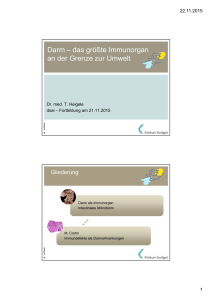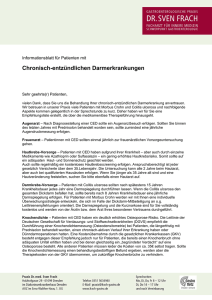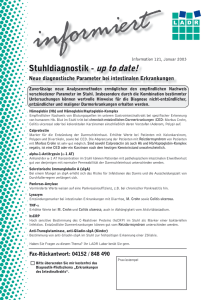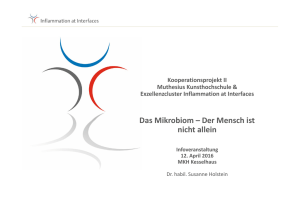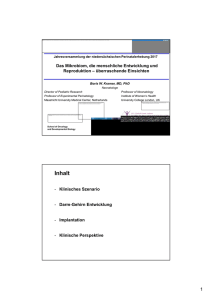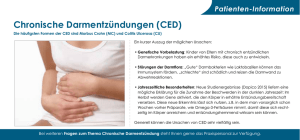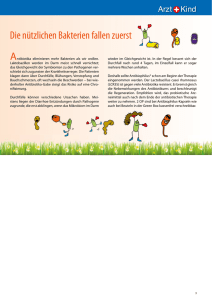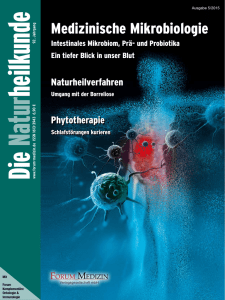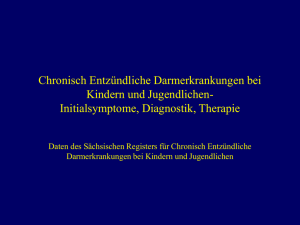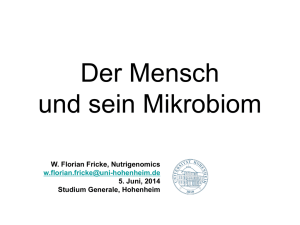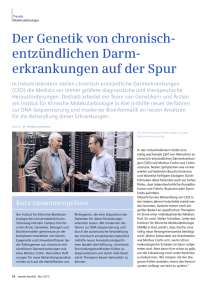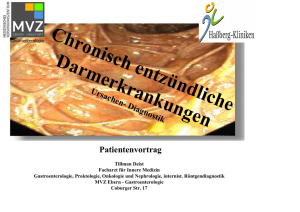Werbung
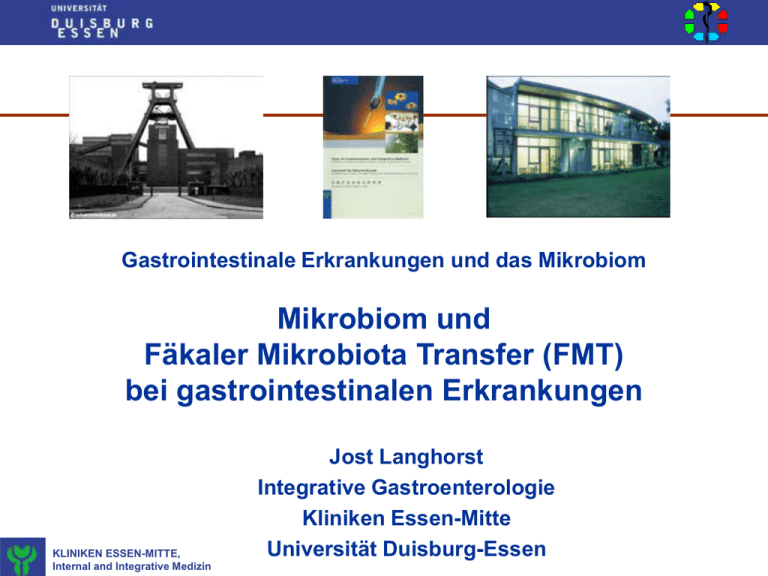
Gastrointestinale Erkrankungen und das Mikrobiom Mikrobiom und Fäkaler Mikrobiota Transfer (FMT) bei gastrointestinalen Erkrankungen KLINIKEN ESSEN-MITTE, Internal and Integrative Medizin Jost Langhorst Integrative Gastroenterologie Kliniken Essen-Mitte Universität Duisburg-Essen Das Mikrobiom des Menschen Was wir von Spucke lernen können: Diversität im Mikrobiom des menschlichen Speichels Forschungsbericht 2011 - Max-Planck-Institut für evolutionäre Anthropologie Das Mikrobiom des Menschen Das 2007 vom US-amerikanischen National Institute of Health (NIH) initiierte Human Microbiome Project hat sich zur Aufgabe gestellt, alle Genome der Mikroorganismen, die den Menschen besiedeln, zu sequenzieren. NIH hat bisher ca 180 Millionen Dollar für Microbiome-assoziierte Forschung vergeben Das Mikrobiom des Menschen Das Mikrobiom des Menschen Im Rahmen des Human Microbiome Project wurden mit der Technik der Gensequezierung die Mitbewohner und deren Verteilung von 242 gesunden Menschen erfasst Forschungsbericht 2011 - Max-Planck-Institut für evolutionäre Anthropologie Molekulare Grundlagen zur Einteilung des Microbioms Phylogenetic marker (16S/18S) rRNA 16S/18S rRNA gene Sequencing (im Ribosomen von Prokaryonten) als Grundlage für die (mikrobielle) Identifikation und Klassifizierung Woese CR et al (1990) Proc Natl Acad Sci USA 87: 4576–4579. 6 Diversity of the microbiota GI microbiota 2006 GI microbiota 2013 Die Hauptgründe für die Zunahme an Wissen im Bereich des Microbioms 1. Entwicklung neuer Technologien 2. Wachsendes Interesse am Forschungsfeld 3. Einschluß neuer Patientengruppen (e.g. Probanden aus dem ländlichen Schwarzafrika)7 Simren et al., Gut, 2013 8 Assoziation von Mikrobiom und verschiedenen Erkrankungen Gut 2006 Colorectal cancer Crohn’s disease Genome Res. 2012 Nat. Rev. Rheumatology 2011 Arthritis Atherosclerosis Nature 2011 J. Med. Microbiol. 2005 Multiple Sclerosis NASH Nature 2012 Nature 2011 Parkinson Disease Eu. J. Neurosci. 2009 Diabetes Autism Freundlich überlassen von Dr. Bork, Heidelberg Obesity Nature 2006 Nature 2012 Mikrobiom • Einführung • Mikrobiom bei CED • Mikrobiologische Therapie bei CED • Stuhltransplantation bei C.diff. Infektionen • Ausblick KLINIKEN ESSEN-MITTE, Internal and Integrative Medizin May 2014 An Irritable Bowel Syndrome subtype defined by speciesspecific alterations in fecal microbiota Jeffery et al Gut 2012 Clustering analysis of irritable bowel syndrome (IBS) and control samples. Dysbiosis of the microbiota in diseases very sick sick healthy Grouping according to the health status among the group of IBS, IBD patients and controls 14 Reduced richness of the community structure in a twin cohort of patients with ulcerative colitis Lepage,…Schreiber.2011. Gastroenterology Low-risk, healthy individual Normal microbiota At-risk relative Crohn’s disease Possible dysbiosis Dysbiosis Higher mucin degraders (Ruminococcus torques) (including lower diversity and lower F. prausnitzii) Environmental triggers ? Intestinal epithelium Intact intestinal barrier Treg Treg Regulatory Th1/ Th17 Hedin et al. Gut 2012 Increased permeability Th1/ Th17 T? Neutrophil activation and calprotectin release Neutrophil activation and calprotectin release Low-risk, healthy individual Normal microbiota At-risk relative Crohn’s disease Possible dysbiosis Dysbiosis Higher mucin degraders (Ruminococcus torques) (including lower diversity and lower F. prausnitzii) Environmental triggers ? Cause or consequence? Intestinal epithelium Intact intestinal barrier Treg Treg Regulatory Th1/ Th17 Hedin et al. Gut 2012 Increased permeability Th1/ Th17 T? Neutrophil activation and calprotectin release Neutrophil activation and calprotectin release Das Mikrobiom bei CED Case-control study CD patients n=537 CDAI <150, 16-35yrs Not eligible: No sibling n=64 Excluded: n= 384 Did not attend or missed n= 63 Met exclusion criteria n= 321 Declined: n=67 Controls n=25 CD patients n=22 Withdrew=1 Contaminated=5 Controls n=19 19 CD siblings n=24 Contaminated=1 CD patients n=21 Withdrew: n=6 Contaminated=1 CD siblings n=17 Case-control study CD patients n=537 CDAI <150, 16-35yrs Not eligible: No sibling n=64 Excluded: n= 384 Did not attend or missed n= 63 Met exclusion criteria n= 321 Declined: n=67 Controls n=25 CD patients n=22 CD siblings n=24 Matched at group level Withdrew=1 Contaminated=5 Controls n=19 20 Contaminated=1 CD patients n=21 Withdrew: n=6 Contaminated=1 CD siblings n=17 Case-control study CD patients n=537 CDAI <150, 16-35yrs Not eligible: No sibling n=64 Excluded: n= 384 Did not attend or missed n= 63 Met exclusion criteria n= 321 Declined: n=67 CD patients n=22 Controls n=25 Withdrew=1 No history of Contaminated=5 IBD Controls n=19 21 CD siblings n=24 Contaminated=1 CD patients n=21 Withdrew: n=6 Contaminated=1 CD siblings n=17 Case-control study CD patients n=537 CDAI <150, 16-35yrs Not eligible: No sibling n=64 Excluded: n= 384 Did not attend or missed n= 63 Met exclusion criteria n= 321 Declined: n=67 CD patients n=22 Controls n=25 Withdrew=1 No history of Contaminated=5 IBS Controls n=19 22 CD siblings n=24 Contaminated=1 CD patients n=21 Withdrew: n=6 Contaminated=1 CD siblings n=17 Methoden Rektale Biopsien (no bowel prep, uninflamed) DNA Extraktion (phenol-chloroform) PCR Amplifikation V1-V3 bacterial 16S rRNA gene 454 Pyrosequenzierung 23 Significant relationship between persistence and abundance Patients p<0.001 Siblings p<0.001 Controls p<0.001 Core Mean taxa abundance Rare Subject occupancy 24 van der Gast CJ et. al ., 2011, ISME J, Vol. 5, 780-791 Morbus Crohn: Die Diversivität des Mikrobioms bei Patienten ist geringer als bei Geschwistern und gesunden Kontrollen Agreement between all three analyses (p<0.05) 25 Control Sibling Crohn’s Key: Geschwister: Diversivität des Core Mikrobioms ist reduziert bei Geschwistern von Crohn Pt verglichen zu gesunden Kontrollen p<0.05 26 Control Sibling Key: Das Core Mikrobiom zeigt mehr Ähnlichkeit zwischen Crohn Pt und deren gesunden Geschwistern als Geschwistern und Gesunden Bray-Curtis Index 27 Den Hauptbeitrag zum Unterschied zwischen Crohn Patienten und gesunden Kontrollen leistet das mukosale Faecalibacterium prausnitzii Mean % abundance Species Mean % % % dissimilarity Contribution Cumulative Crohn’s Healthy Faecalibacterium prausnitzii 20.7 30.0 16.4 22.4 22.4 Escherichia fergusonii 20.4 3.9 10.5 14.4 36.7 Shigella flexneri 12.8 3.5 6.8 9.3 46.0 Ruminococcus gnavus 12.4 4.0 6.3 8.6 54.6 Bacteroides vulgatus 8.9 7.9 5.9 8.0 62.7 Eubacterium rectale 9.1 9.5 5.4 7.4 70.1 Sutterella wadsworthensis 0.0 8.6 4.7 6.4 76.5 Oscillospira guilliermondii 0.0 8.1 4.6 6.2 82.8 Escherichia coli 6.0 0.0 3.3 4.4 87.2 Bacteroides uniformis 0.0 2.8 1.6 2.1 89.3 Roseburia faecis 0.0 2.4 1.3 1.8 91.1 28 Den Hauptbeitrag zum Unterschied zwischen Crohn Geschwistern und gesunden Kontrollen leistet das mukosale Faecalibacterium prausnitzii Mean % abundance Species Faecalibacterium prausnitzii 29 Mean % % % dissimilarity Contribution Cumulative Siblings Healthy 23.4 30.0 10.4 18.9 18.9 Escherichia fergusonii 9.6 3.9 5.8 10.6 29.5 Sutterella wadsworthensis 5.8 8.6 5.2 9.4 38.9 Shigella flexneri 6.9 3.5 4.6 8.4 47.3 Bacteroides vulgatus 7.3 7.9 4.6 8.4 55.7 Eubacterium rectale 6.1 9.5 3.9 7.0 62.8 Oscillospira guilliermondii 7.6 8.1 3.9 7.0 69.8 Bacteroides dorei 5.5 0 3.0 5.4 75.2 Ruminococcus gnavus 4.7 4.0 2.2 4.1 79.3 Bacteroides uniformis 1.9 2.8 1.7 3.1 82.4 Roseburia faecis 3.7 2.4 1.7 3.0 85.4 Low-risk, healthy individual At-risk relative Mucosal dysbiosis ↓ Diversity ↓ F. prausnitzii Normal microbiota Environmental triggers Crohn’s disease Mucosal dysbiosis ↓ Diversity ↓ F. prausnitzii ↑ E. coli Intestinal epithelium Intact intestinal barrier Treg Treg Regulatory Th1/ Th17 Hedin et al. Gut 2012 Increased permeability ↓ ↓ CD4 CD4 ↓ CD4 Neutrophil activation and calprotectin release Th1/ Th17 Mucosal Faecalibacterium prausnitzii n=13 31 Sokol et al. PNAS 2008 Das Mikrobiom bei CED Das Mikrobiom bei CED Fäkaler Stuhltranfer bei CED Die Geschichte der Stuhltransplantation/Therapie • Vor >1000 Jahren wurde in der Traditionell Chinesischen Medizin Patienten mit schweren Diarrhoen mit “gelber Suppe” behandelt, eine Aufbereitung von Stuhl und Wasser http://www.hopkinschildrens.org/Hope-for-Cure-ofChildhood-Diarrhea-Comes-Straight-from-the-Gut.aspx • Seit dem 16. Jahrhundert: Nachweis von “Transfaunation”: Erkrankte Rinder wurde mit dem Darminhalt gesunder Rinder behandelt • 19. Jahrhundert: Bedouinen in Nord Afrika: Orale Aufnahme von Kamel Stuhl zur Therapie von Diarrhoe as (bakterielle Dysenterie) • 2. Weltkrieg: Von Soldaten im Afrikakrieg eingesetzt • 1958: Stuhleinläufe zur Therapie der pseudomembranösen Colits Eiseman et al. Surgery 1958 Fecal microbiota transplantation (FMT): Publications Pubmed January 2014 Wichtige Punkte • • • • • Auswahl des Spenders Vorbereitung des „Transplantats“ Form der Applikation Vorbereitung des Patienten Begleitende Therapie Auswahl des Spenders • Verwandte/bekannte Spender werden bevorzugt - Partner - Familienmitglieder - Freunde • Rationale: Vergleichbares Infektionsspektrum in der Anamnese • Aber: Höheres Risiko die Screening Kriterien nicht zu erfüllen Starkey et al. JAMA 1989 • Dennoch: Von den Patienten gewünscht Auswahl des Spenders Sha et al. APT 2014 All information on pts published in English 1958-05/2013 Screening-Untersuchung des Spenders Ausschlußkriterien • Infektion in der jüngeren Vergangenheit • Autoimmunkrankheit, Allergien • CED oder andere (chronische) gastrointestinale Erkrankungen • Adipositas, Metabolisches Syndrom • Medikation mit potentiellem Einfluß • Antibiotika! • Auslandsaufenthalte (in Ländern mit niedrigen Hygienestandards) • Tätowierung (in den letzten 6 Monaten) • Risikoreiches Sexualverhalten/ Promiskuität • Drogenmißbrauch • Psychiatrische Krankheiten • Neurologische Krankheiten Screening-Untersuchung des Spenders Weitere Ausschlußkriterien • Serologische Marker • HIV 1 und 2 • Hepatitis A, B, C • Syphilis (TPHA) • Yersinia, campylobacter, entameba (AB) • Stuhlmarker • Ova und Parasiten • Bakterielle Infektionen (einschließlich EHEC, salmonella, shigella,yersinia, campylobacter, giardia AG) • Clostridium difficile (Toxin + GLDH, PCR bei diskrepanten Ergebnissen) Auswahl des Spenders „We have found that more than 90% of potential donors do not pass the screening evaluations“. Khoruts, Minneapolis Petrof & Khoruts Gastroenterology 2014 „Most recipients are not able to indentify and recruit a donor.“ Applikationsform Sha et al. APT 2014 Vorbereitung des Patienten Landy et al. APT 2011; Sha et al. APT 2014 Preparation • Keine • Antibiotische Vorbehandlung • Kolonlavage • Keine Antibiotika 48 h vor der Applikation • (Loperamid?) • (Probiotische Therapie des Spenders?) Begleitende Therapie • Keine • Überwachung für (24-) 48 h • Untersuchung des Microbioms • Wiederholte Transplantation (bis zu 69x) FMT Was verabreichen wir? • Bakterien • Viren • Parasiten • Pro-infammatorische Proteine • Anti-inflammatorische Proteine Fäkaler Stuhltranfer bei CED • Patienten mit chronische entzündlichen Darmerkrankungen haben einen relativen Mangel an Diversivität (Vielfalt) in ihrem Mikrobiom (eine relative Dysbiose). • Ob eine mikrobiellen Therapie mit Stuhl von gesunden Spendern (Fäkale Mikrobiota Therapie/Transplantation FMT) einen positiven therapeutischen Effekt bei IBD erzielen kann ist derzeit im Fokus verschiedener klinischer Studien. Fäkaler Stuhltranfer bei Morbus Crohn Fäkaler Stuhltranfer bei Colitis ulcerosa Fäkaler Stuhltranfer bei Colitis ulcerosa Mikrobiom • Einführung • Mikrobiom bei CED • Mikrobiologische Therapie bei CED • Stuhltransplantation bei C.diff. Infektionen • Ausblick KLINIKEN ESSEN-MITTE, Internal and Integrative Medizin Stuhltransplantation bei CED Meta-analyse: Stuhlransplantation bei rezidivierender C. diff-Colitis Kassam Z et al, Am J Gastroenterol 2013;108:500-8 Fäkaler Stuhltranfer bei C.diff. Infektion 80 Cases included adult (75) and pediatric (5) patients treated with FMT for recurrent (55 % ), refractory (11 % ), and severe and / or overlap of recurrent / refractory and severe CDI (34 % ). The mean follow-up period between FMT and data collection was 11 months (range 3 – 46 months). Reasons for IC included: HIV / AIDS (3), solid organ transplant (19), oncologic condition (7), immunosuppressive therapy for inflammatory bowel disease (IBD; 36), and other medical conditions / medications (15). The CDI overall cure rate was 89 % . Am J Gastro, 2014 Fäkaler Stuhltranfer bei C.diff. Infektion Am J Gastro, 2014 Mikrobiom • Einführung • Mikrobiom bei CED • Mikrobiologische Therapie bei CED • Stuhltransplantation bei C.diff. Infektionen • Ausblick KLINIKEN ESSEN-MITTE, Internal and Integrative Medizin Fäkaler Stuhltranfer bei C.diff Infektion Stuhlbank University of Minnesota OpenBiome (MIT), Cambridge, MA Spezielle intestinale Bakterienkulturen Gereinigte intestinale Bakterienkulturen aus Stuhl Eine Kombination aus 6 Bakterienstämmen ist effektiv im Tiermodell Stool Bank OpenBiome 196 Boston Avenue Medford, MA 02155 Costs: 250,-$ per fecal sample plus shipping «AIM: Providing hospitals with screened, filtered and frozen material.» Fäkaler Stuhltranfer bei C.diff. Infektion
